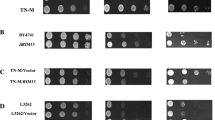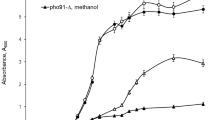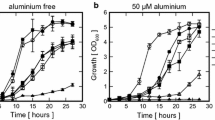Abstract
We have taken a systematic genetic approach to study the potential role of glutathione metabolism in aluminum (Al) toxicity and resistance, using disruption mutants available in Saccharomyces cerevisiae. Yeast disruption mutants defective in phospholipid hydroperoxide glutathione peroxidases (PHGPX; phgpx1 Δ, phgpx2 Δ, and phgpx3Δ), were tested for their sensitivity to Al. The triple mutant, phgpx1 Δ/2Δ/3Δ, was more sensitive to Al (55% reduction in growth at 300 μM Al) than any single phgpx mutant, indicating that the PHGPX genes may collectively contribute to Al resistance. The hypersensitivity of phgpx3Δ to Al was overcome by complementation with PHGPX3, and all PHGPX genes showed increased expression in response to Al in the wild-type strain (YPH250), with maximum induction of approximately 2.5-fold for PHGPX3. Both phgpx3Δ and phgpx1Δ/2Δ/3Δ mutants were sensitive to oxidative stress (exposure to H2O2 or diamide). Lipid peroxidation was also increased in the phgpx1Δ/2Δ/3Δ mutant compared to the parental strain. Disruption mutants defective in genes for glutathione S-transferases (GSTs) (gtt1Δ and gtt2Δ), glutathione biosynthesis (gsh1Δ and gsh2Δ), glutathione reductase (glr1Δ) and a glutathione transporter (opt1Δ) did not show hypersensitivity to Al relative to the parental strain BY4741. Interestingly, a strain deleted for URE2, a gene which encodes a prion precursor with homology to GSTs, also showed hypersensitivity to Al. The hypersensitivity of the ure2Δ mutant could be overcome by complementation with URE2. Expression of URE2 in the parental strain increased approximately 2-fold in response to exposure to 100 μM Al. Intracellular oxidation levels in the ure2Δ mutant showed a 2-fold (non-stressed) and 3-fold (when exposed-to 2 mM H2O2) increase compared to BY4741; however, the ure2Δ mutant showed no change in lipid peroxidation compared to the control. The phgpx1Δ/2Δ/3Δ and ure2Δ mutants both showed increased accumulation of Al. These findings suggest the involvement of PHGPX genes and a novel role of URE2 in Al toxicity/resistance in S. cerevisiae.








Similar content being viewed by others
References
Avery SV (2001) Metal toxicity in yeasts and the role of oxidative stress. Adv Appl Microbiol 49:111–142
Avery AM, Avery SV (2001) Saccharomyces cerevisiae expresses three phospholipid hydroperoxide glutathione peroxidases. J Biol Chem 276:33730–33735
Bao YP, Williamson G (2000) Selenium-dependent glutathione peroxidases—a highlight of the role of phospholipid hydroperoxide glutathione peroxidase in protection against oxidative damage. Prog Nat Sci 10:321–330
Basu U, Good AG, Taylor GJ (2001) Transgenic Brassica napus plants overexpressing aluminium-induced mitochondrial manganese superoxide dismutase cDNA are resistant to aluminium. Plant Cell Environ 24:1269–1278
Blinder D, Coschigano PW, Magasanik B (1996) Interaction of the GATA factor Gln3p with the nitrogen regulator Ure2p in Saccharomyces cerevisiae. J Bacteriol 178:4734–4736
Blokhina O, Virolainen E, Fagerstedt KV (2003) Antioxidants, oxidative damage and oxygen deprivation stress: a review. Ann Bot 91:179–194
Bousset L, Belrhali H, Melki R, Morera S (2001) Crystal structures of the yeast prion Ure2p functional region in complex with glutathione and related compounds. Biochemistry 40:13564–13573
Collinson EJ, Grant CM (2003) Role of yeast glutaredoxins as glutathione S-transferases. J Biol Chem 278:22492–22497
Collinson EJ, Wheeler GL, Garrido EO, Avery AM, Avery SV, Grant CM (2002) The yeast glutaredoxins are active as glutathione peroxidases. J Biol Chem 277:16712–16717
Cooper TG (2002) Transmitting the signal of excess nitrogen in Saccharomyces cerevisiae from the Tor proteins to the GATA factors: connecting the dots. FEMS Microbiol Rev 26:223–238
Coschigano PW, Magasanik B (1991) The URE2 gene product of Saccharomyces cerevisiae plays an important role in the cellular response to the nitrogen source and has homology to glutathione- S -transferases. Mol Cell Biol 11:822–832
Cox KH, Pinchak AB, Cooper TG (1999) Genome-wide transcriptional analysis in S. cerevisiae by mini-array membrane hybridization. Yeast 15:703–713
Dat J, Vandenbeele S, Vranova E, Van Montagu M, Inzé D, Van Breusegm F (2000) Dual action of the active oxygen species during plant stress responses. Cell Mol Life Sci 57:779–795
Delaunay A, Pflieger D, Barrault MB, Vinh J, Toledano MB (2002) A thiol peroxidase is an H2O2 receptor and redox-transducer in gene activation. Cell 111:471–481
Devi SR, Yamamoto Y, Matsumoto H (2003) An intracellular mechanism of aluminum tolerance associated with high antioxidant status in cultured tobacco cells. J Inorg Biochem 97:59–68
Dixon DP, Cummins I, Cole DJ, Edwards R (1998) Glutathione-mediated detoxification systems in plants. Curr Opin Plant Biol 1:258–266
Edwards R, Dixon DP, Walbot V (2000) Plant glutathione- S -transferases: enzymes with multiple functions in sickness and in health. Trends Plant Sci 5:193–198
Ezaki B, Sivaguru M, Ezaki Y, Matsumoto H, Gardner RC (1999) Acquisition of aluminum tolerance in Saccharomyces cerevisiae by expression of the BCB or NtGDI1 gene derived from plants. FEMS Microbiol Lett 171:81–87
Ezaki B, Gardner RC, Ezaki Y, Matsumoto H (2000) Expression of aluminum-induced genes in transgenic Arabidopsis plants can ameliorate Al stress and/or oxidative stress. Plant Physiol 122:657–665
Ezaki B, Katsuhara M, Kawamura M, Matsumoto H (2001) Different mechanisms of four aluminum (Al)-resistant transgenes for Al toxicity in Arabidopsis. Plant Physiol 127:918–927
Fraser JA, Davis MA, Hynes MJ (2002) A gene from Aspergillus nidulans with similarity to URE2 of Saccharomyces cerevisiae encodes a glutathione- S -transferase. Appl Environ Microbiol 68:2802–2808
Gietz RD, Schiestl RH, Willems A, Woods RA (1995) Studies on the mechanism of high efficiency transformation of intact yeast cells. Yeast 11:355–360
Gu Z, Steinmetz LM, Gu X, Scharfe C, Davis RW, Li WH (2003) Role of duplicate genes in genetic robustness against null mutations. Nature 421:63–66
Hamilton CA, Good AG, Taylor GJ (2001) Vacuolar H+ -ATPase, but not mitochondrial F1F0-ATPase, is required for aluminum resistance in Saccharomyces cerevisiae. FEMS Microbiol Lett 205:99–105
Herbette S, Lenne C, Leblanc N, Julien JL, Drevet JR, Roeckel-Drevet P (2002) Two GPX-like proteins from Lycopersicon esculentum and Helianthus annuus are antioxidant enzymes with phospholipid hydroperoxide glutathione peroxidase and thioredoxin peroxidase activities. Eur J Biochem 269:2414–2420
Inoue Y, Matsuda T, Sugiyama KI, Izawa S, Kimura A (1999) Genetic analysis of glutathione peroxidase in oxidative stress response of Saccharomyces cerevisiae. J Biol Chem 274:27002–27009
Kochian LV (1995) Cellular mechanisms of aluminum toxicity and resistance in plants. Annu Rev Plant Physiol Plant Mol Biol 46:237–260
Li WJ, Feng H, Fan JH, Zhang, RQ, Zhao NM, Liu JY (2000) Molecular cloning and expression of a phospholipid hydroperoxide glutathione peroxidase homolog in Oryza sativa. Biochim Biophys Acta 1493:225–230
Matsumoto H (2000) Cell biology of aluminum toxicity and tolerance in higher plants. Int Rev Cytol 200:1–46
Mittler R (2002) Oxidative stress, antioxidants and stress tolerance. Trends Plant Sci 7:405–410
Rai R, Tate JJ, Cooper TG (2003) Ure2, a prion precursor with homology to glutathione S -transferase, protects Saccharomyces cerevisiae cells from heavy metal ion and oxidant toxicity. J Biol Chem 278:12826–12833
Rao KS, Easwaran KR (1997) 27Al-NMR studies of aluminum transport across yeast cell membranes. Mol Cell Biochem 175:59–63
Richards KD, Schott EJ, Sharma YK, Davis KR, Gardner RC (1998) Aluminum induces oxidative stress genes in Arabidopsis thaliana. Plant Physiol 116:409–418
Roxas VP, Lodhi SA, Garrett DK, Mahan JR, Allen RD (2000) Stress tolerance in transgenic tobacco seedlings that overexpress glutathione- S -transferase/glutathione peroxidase. Plant Cell Physiol 41:1229–1234
Sambrook J, Fritsch EF, Maniatis T (1989) Molecular cloning: a laboratory manual (2nd edn). Cold Spring Harbor Laboratory Press, Cold Spring Harbor, N.Y.
Schott EJ, Gardner RC (1997) Aluminum-sensitive mutants of Saccharomyces cerevisiae. Mol Gen Genet 254:63–72
Sherman F (1991) Getting started with yeast. Methods Enzymol 194:3–21
Sugimoto M, Sakamoto W (1997) Putative phospholipid hydroperoxide glutathione peroxidase gene from Arabidopsis thaliana induced by oxidative stress. Genes Genet Syst 72:311–316
Taylor GJ, Stephens JL, Hunter DB, Bertsch PM, Elmore D, Rengel Z, Reid R (2000) Direct measurement of aluminum uptake and distribution in single cells of Chara corallina. Plant Physiol 23:987–996
Umland TC, Taylor KL, Rhee S, Wickner RB, Davies DR (2001) The crystal structure of the nitrogen regulation fragment of the yeast prion protein Ure2p. Proc Natl Acad Sci USA 98:1459–1464
Wagner U, Edwards R, Dixon DP, Mauch F (2002) Probing the diversity of the Arabidopsis glutathione- S -transferase gene family. Plant Mol Biol 49:515–532
Winzeler EA, et al (1999) Functional characterization of the S. cerevisiae genome by gene deletion and parallel analysis. Science 285:901–906
Withee JL, Sen R, Cyert MS (1998) Ion tolerance of Saccharomyces cerevisiae lacking the Ca2+/CaM-dependent phosphatase (Calcineurin) is improved by mutations in URE2 or PMA1. Genetics 149:865–878
Yamamoto Y, Hachiya H, Matsumoto H (1997) Oxidative damage to membranes by a combination of aluminum and iron in suspension cultured tobacco cells. Plant Cell Physiol 38:333–1339
Yamamoto Y, Kobayashi Y, Matsumoto H (2001) Lipid peroxidation is an early symptom triggered by aluminum, but not the primary cause of elongation inhibition in pea roots. Plant Physiol 125:199–208
Yamamoto Y, Kobayashi Y, Devi SR, Rikiishi S, Matsumoto H (2002) Aluminum toxicity is associated with mitochondrial dysfunction and the production of reactive oxygen species in plant cells. Plant Physiol 128:63–72
Acknowledgements
A Research Grant from the Natural Science and Engineering Research Council of Canada provided financial support for this work. All the phgpx mutants (derivatives of YPH250, Yeast Genetic Stock Centre, University of California, Berkeley) and plasmids (pUGPH6, pUG14, pUGPJ16) used in this study were obtained from Dr. Yoshiharu Inoue (Kyoto University, Japan). Plasmid pRS424 was a gift from Dr. Mark McCammon (University of Texas Health Science Center, San Antonio, Tex.)
Author information
Authors and Affiliations
Corresponding author
Additional information
Communicated by D.Y. Thomas
Rights and permissions
About this article
Cite this article
Basu, U., Southron, J.L., Stephens, J.L. et al. Reverse genetic analysis of the glutathione metabolic pathway suggests a novel role of PHGPX and URE2 genes in aluminum resistance in Saccharomyces cerevisiae . Mol Genet Genomics 271, 627–637 (2004). https://doi.org/10.1007/s00438-004-1015-7
Received:
Accepted:
Published:
Issue Date:
DOI: https://doi.org/10.1007/s00438-004-1015-7




